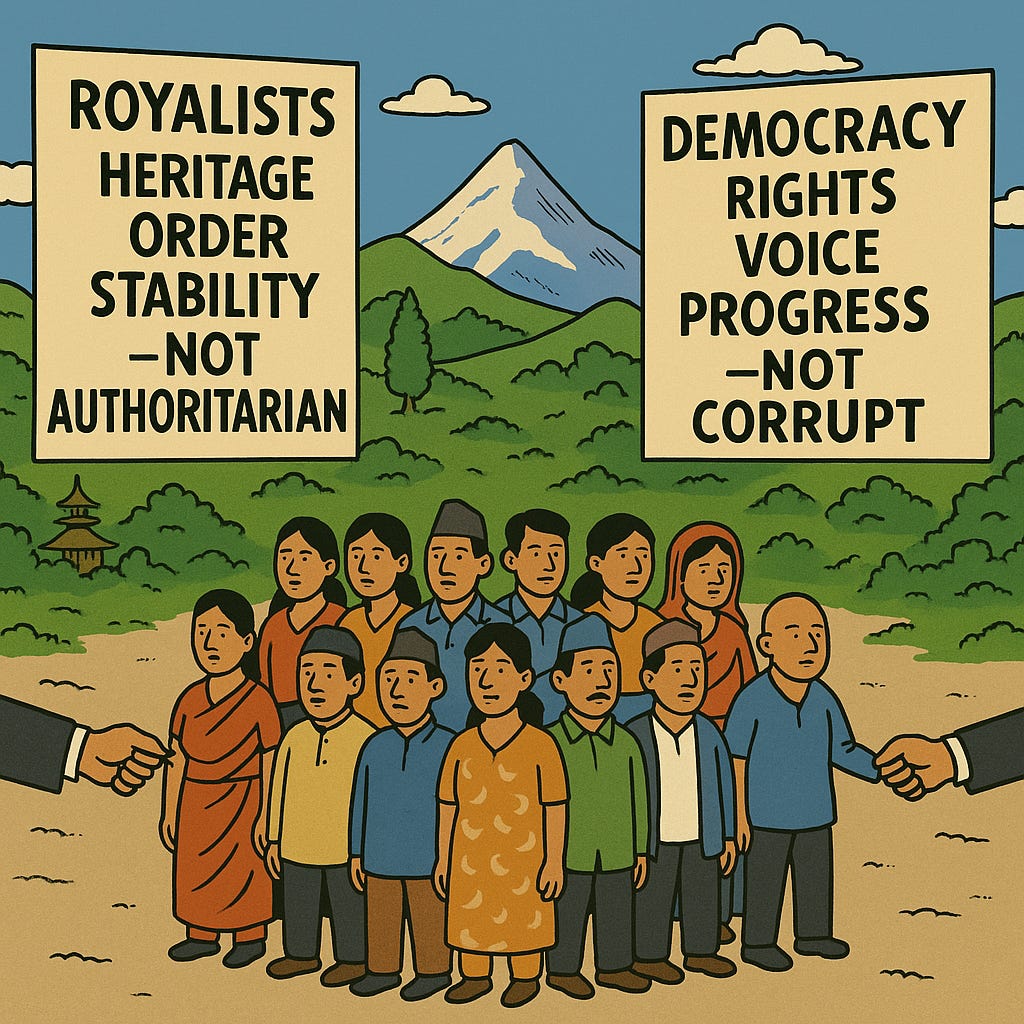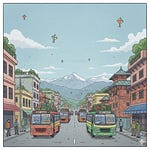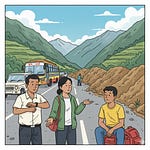Know someone who cares about Nepal? Pass this along and help grow our circle of informed insiders. Subscribe for crisp, curated updates you won’t find anywhere else.
Royal nostalgia turned riotous, the economy’s walking a tightrope, and the glaciers are melting faster than the government can reform. From street protests to diaspora demands, it's been a week of high drama and slow broadband — but hey, at least we got a World Bank bridge loan. Let’s dive in!
Politics & Governance 🪧
This week has seen an outburst of pro-monarchy sentiment in Kathmandu, where royalist demonstrators, frustrated with longstanding political figures, clashed violently with security forces at Tinkune. According to MyRepublica, the protests escalated on Friday when some supporters of former King Gyanendra allegedly breached police barricades, leading to two deaths (including a journalist) and extensive property damage. Eyewitness accounts describe arson attacks, looting at Bhatbhateni Supermarket, and a tense standoff as the local administration briefly imposed a curfew to contain the unrest.
In the aftermath, KTM Post reports that the ruling Nepali Congress publicly held the ex-king responsible, while other parties and rights groups demanded investigations and swift legal action against the perpetrators. Home Minister Ramesh Lekhak condemned attacks on media houses and vowed to bring any criminal actors to justice. Meanwhile, the Kathmandu Metropolitan City fined Gyanendra Rs793,000 for environmental damage and destruction of public property, and the government is said to be exploring revocation of his state privileges.
High-profile arrests followed: according to THT, police detained dozens of protest organizers, including senior Rastriya Prajatantra Party figures, on charges of inciting violence. Organizers like controversial medical entrepreneur Durga Prasai reportedly fled the scene, heightening public debate over whether the unrest was a spontaneous expression of deep-seated public dissatisfaction or a deliberate bid to reassert monarchical power. While many Nepalis remain disillusioned with the current political elite, observers note that official steps—such as downsizing Gyanendra’s security detail and announcing investigations—signal the government’s intent to curb any return to absolute rule.
This latest wave of unrest serves as a stark reminder of Nepal’s complex relationship with its monarchy, abolished in 2008 after a decade-long civil conflict and massive pro-democracy demonstrations. Although public frustration with corruption and political instability fuels some royalist sentiment, most Nepalis remain wary of reversing democratic gains. As tensions continue to simmer, the coming weeks will test the government's ability to address deep-rooted grievances while maintaining social stability and democratic norms.
We strive to present these developments as neutrally as possible, offering relevant context for readers following Nepal’s evolving political scene. Our newsletter aims to keep you informed, but we encourage you to explore multiple perspectives and stay engaged with the facts as the situation unfolds.
Economy & Development 💸
Nepal’s economy grew by 5.1 percent in the second quarter of the current fiscal year, though after seasonal adjustments the growth was a more modest 2.2 percent. Transportation, construction, agriculture, electricity, and finance drove the gains, while sectors like housing and education lagged. The standout performer was the transportation and storage sector, which posted 14.2 percent growth. Manufacturing grew by 7.4 percent, buoyed by higher domestic production and imports. Agriculture, despite being the largest contributor to GDP, grew by just 3.2 percent, although improvements in rice and fruit production helped (Republica).
At the same time, the number of Nepalis in the tax net has surged to over 6.65 million, even as revenue collection continues to lag behind government targets. Income tax rose by just 3.2 percent, while government spending has already exceeded Rs 869 billion, creating mounting pressure on public finances. The gap between revenue and expenditure has left a budget deficit of over Rs 132 billion (MyRepublica). Meanwhile, the World Bank has warned that Nepal risks long-term stagnation with growth stuck at around 4 percent unless major reforms are introduced in infrastructure, private sector development, and labor productivity. Despite impressive gains in poverty reduction fueled by remittances, Nepal’s long-term prospects could falter without decisive policy shifts (MyRepublica).

Power shortages and climate threats are weighing heavily on Nepal’s development path. Prolonged 12-hour load shedding has slashed industrial production by over 50 percent, pushing up costs and disrupting supply chains across sectors like steel and cement (MyRepublica). Yet some positive news came as the World Bank approved $150 million to strengthen climate-resilient bridges across Nepal’s rugged terrain (THT). And with glacial melt accelerating in the Himalayas, KTM Post spotlighted how Nepal’s glaciers are retreating faster than ever — a trend that could imperil water, hydropower, and food security unless addressed through urgent policy and global support (KTM Post).
Did you know ❓
Nepal’s informal economy — which includes unregistered businesses, off-the-books jobs, and other under-the-radar economic activity — makes up a staggering 41% of the country’s GDP. That means nearly half of all economic output operates outside the formal system, often without regulation or taxation. While the informal sector plays a vital role in providing jobs and sustaining livelihoods, especially in rural and urban low-income communities, it also presents serious challenges to tax collection, economic planning, and worker protections. These insights come from recent data released by Nepal’s National Statistics Office (March 2024), offering a rare official look into just how deeply informal work is woven into the country's economic fabric (MyRepublica).
Diaspora & Globalization 🌎
Calls for clearer laws and citizenship rights topped the agenda at the 16th Europe Regional Conference of the Non-Resident Nepali Association (NRNA), held in Malta. Non-resident Nepalis urged the government to streamline legal frameworks and honor constitutional provisions on citizenship to attract diaspora investment, citing examples from India and China where political stability has spurred growth. Industry Minister Damodar Bhattarai acknowledged bureaucratic hurdles and committed to raising these concerns with the Prime Minister. Meanwhile, internal tensions within the NRNA persist: a high-level committee led by Dr. Shesh Ghale, mandated by the Supreme Court, has clashed with a faction organizing parallel programs abroad. The committee warned of possible dissolution of the NRNA if a unification convention is not held by mid-May. MyRepublica
Meanwhile, Nepal’s regional and global ties were in the spotlight. A month-long Sichuan-Nepal trade, tourism, and cultural exchange kicked off in Chengdu, with Nepali officials and businesses showcasing local products and strengthening ties with China’s Sichuan province. The events aim to deepen people-to-people and economic relations. Nepal News In a more troubling development, 10 Bhutanese individuals deported from the U.S. for criminal activities were refused reentry by Bhutan and rerouted to Nepal, sparking legal and human rights concerns. Three were arrested in Beldangi refugee camp, while the rest remain in hiding. Refugee advocates warn that such deportations — and Bhutan’s rejection of its own nationals — are leaving lives in limbo, and call for coordinated action from Nepal and Bhutan to resolve the growing uncertainty. KTM Post
Social & Cultural ⭐
Nothing to highlight in this section this week — royal developments etc continue to dominate the national conversation.
Let’s connect
Enjoying this issue? 📩 Share it with a friend & let’s keep Nepalis worldwide in the loop! Got thoughts? Hit reply—we’re all ears! Or let us know what you think via our Feedback form or follow us on Facebook | LinkedIn
P.S. Got a story or issue you'd like us to cover next week? Drop us a reply — we're building this space together.
About Nepali Diaspora Digest:
The Nepali Diaspora Digest connects the global Nepali community with curated news, insights, and stories that matter most. Join us as we celebrate and explore the diverse voices and achievements of Nepalis worldwide.
Partner shout out
belayat.uk: helping Nepalis connect in the UK on jobs, housing, events and finding local Nepali owned businesses














